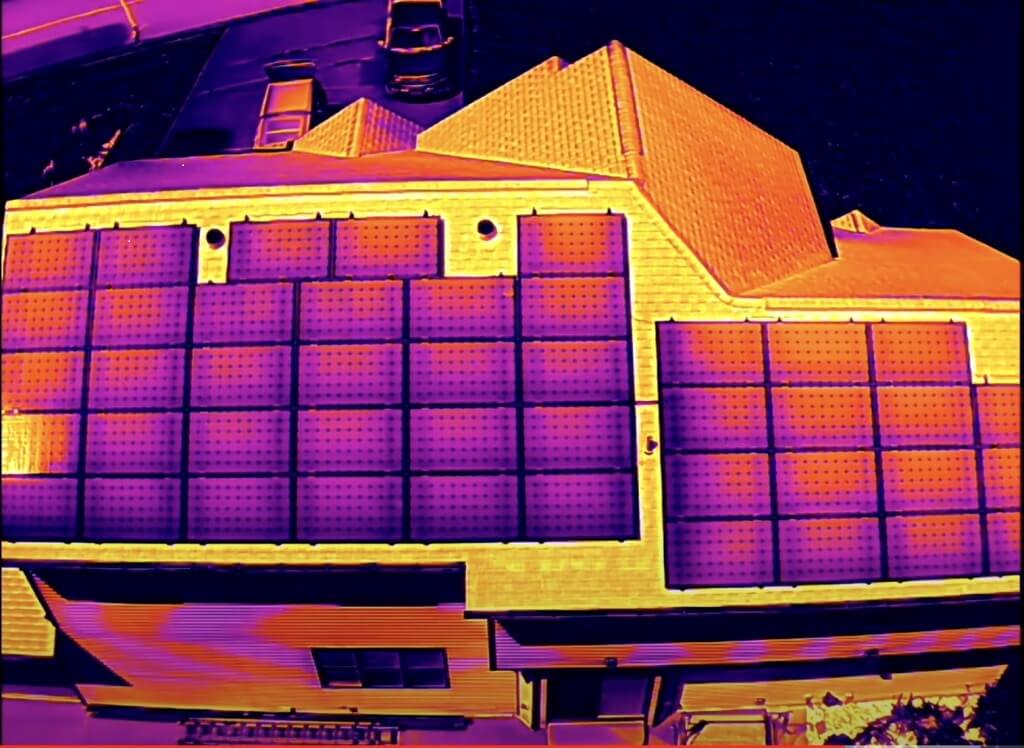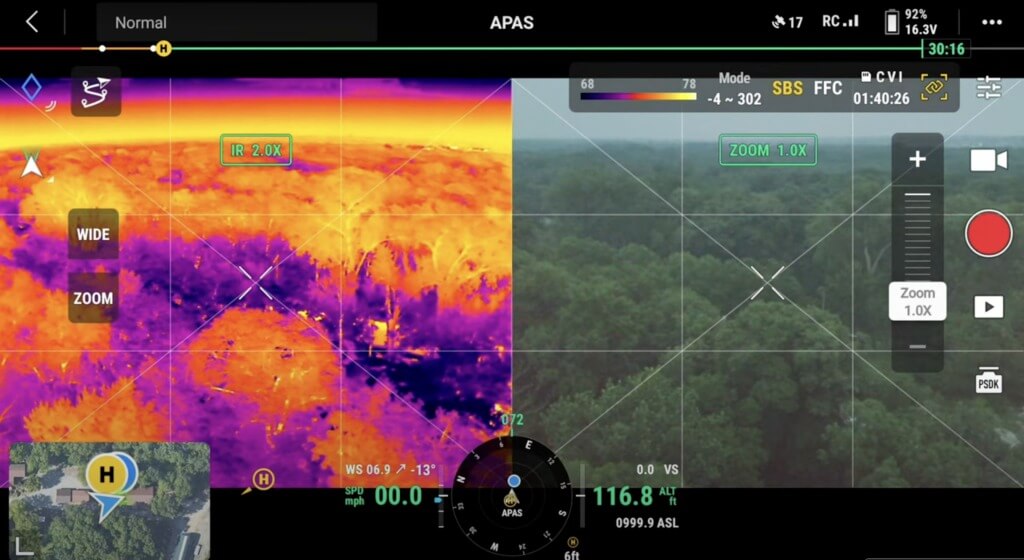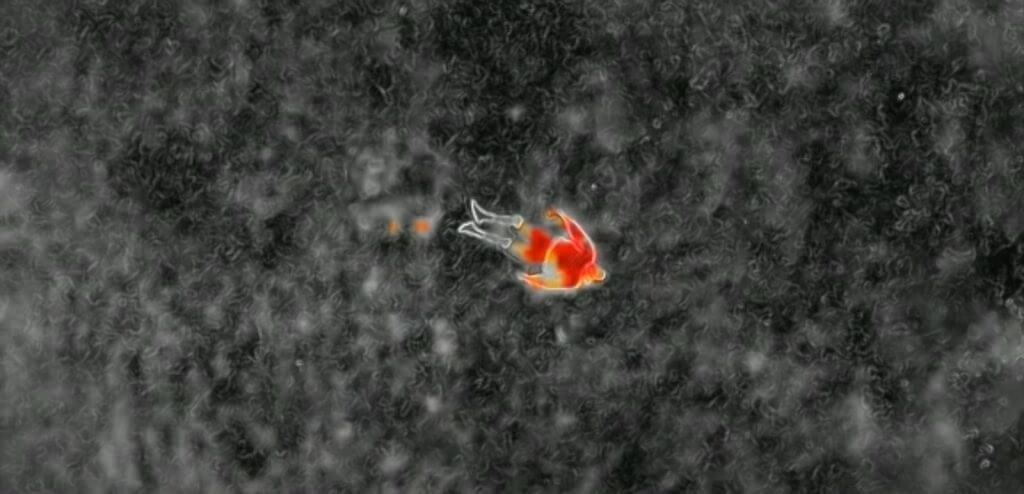Explore the game-changing advantages of aerial thermography for solar inspections! Discover the top 8 benefits that maximize performance.

Renewable energy sources will contribute to 36.8% of Australian energy demand in 2022–2023. Solar power is the most common renewable energy source in Australia.
The amount of raw solar energy accessible to the planet has resulted in significant attempts in recent years to develop solar panel technology to make solar assets more efficient and cost-effective.
Aerial thermography is the most recent technique for assessing photovoltaic (PV) solar panels and is proven to be the best method of maximizing solar assets at the commercial level.
What Is Aerial Thermography For Solar Inspections?
Aerial thermography is used for solar checks and entails flying over the entire site using drones or manned aircraft and scanning all modules with infrared (IR) cameras.
The scans are combined to provide a full thermal picture of the solar farm. This scan helps identify problems in solar farms.
In growing pace of solar energy requires new solar installations and the maintenance of the thousands of solar installations currently completed.
Tracking the state and condition of a few hundred panels is a lot of effort for even a tiny solar farm.
Consider the difficulty of managing the millions of solar panels at Spruiked, Australia’s largest solar farm, the 400-megawatt project near Chinchilla.
Previously, inspections had to be performed manually, one row at a time. Fortunately, new tools like aerial thermography are transforming solar panel inspections.
Aerial thermography Vs. Traditional thermography
Aerial thermography solar PV inspection is superior to traditional manual inspection and I-V curve tracing due to its increased efficiency, cost-effectiveness, and safety.
Traditional methods of assessing PV solar farms include in-house personnel doing field walks and I-V curve tracing.
I-V curve tracing employs sensors on strings of PV modules to monitor current and power as a function of voltage, comparing the data to predicted figures to find which strings are underperforming.

Drones and aircraft can inspect solar farms at rates that are orders of magnitude faster than manual inspection. Time efficiency turns into reduced labor costs and reduced hazardous manhours.
Aerial inspection allows maintenance of solar modules to be performed often and efficiently, saving solar PV farm owners money and time.
Benefits Of Aerial Thermography for Solar Inspections
Precision And Accuracy
Aerial thermography examinations are a popular alternative to overview and comprehensive inspections.
They enable a quick yet thorough examination of all solar PV system modules. They can accurately identify big-scale and sub-module-level irregularities.
This makes the examination excellent for yearly preventive maintenance checks as well as assisting teams dealing with locations that have recurring problems.
They cannot, however, measure temperatures to the millimeter. Overall, these inspections deliver a lot of information rapidly, allowing for speedy and data-driven asset management and O&M decision-making.
While aerial thermography is frequently the most effective technique for inspecting a solar PV system for performance concerns, knowing the amount of inspection required will allow you to maximize ROI.
Early Detection Of Issues
Drone thermography can identify quality, construction, and commissioning issues at an early stage, avoiding early yield and revenue loss.
At provisional acceptance certification (PAC), aerial thermography gives an early health baseline for 100% of the modules as well as a detailed plan for the engineering, procurement, and construction firm (EPC) to rectify any detected concerns.
High-quality thermographic and high-definition visual RGB camera examinations, along with a sophisticated software solution, enable you to shift from a reactive to a proactive maintenance plan.
Additionally, drone thermography methods are proficient in identifying high-impact anomalies, though they may not detect more subtle issues. Despite this limitation, the technology proves valuable for spotting critical faults in solar photovoltaic plants.
Cost-Effectiveness
Aerial thermography is a low-cost approach for assessing solar-generating systems.
Optimized thermography flight methods from unmanned aerial vehicles (UAVs) provide efficient fault assessment in solar parks, increasing the overall cost-effectiveness of the operation.
Aerial thermography solar PV inspection is more efficient and cost-effective than traditional manual inspection and I-V curve tracing.
Infrared drone inspections, in particular, are expected to lower thermographic inspection costs for utility-scale solar farms by roughly 30%, resulting in a positive return on investment (ROI).
Finally, the use of aerial thermography, particularly with UAVs and infrared drones, is a cost-effective means of evaluating solar projects, providing efficient flaw diagnostics as well as significant time and money savings.
Reduce Inspection Time
Aerial thermography for solar assessments provides a substantial benefit by shortening inspection time.
Large photovoltaic (PV) systems may be inspected quickly and efficiently using drones equipped with high-resolution thermal technology.
This system monitors temperature variations and provides critical information faster than older approaches.
Annual aerial thermography checks are routinely included in preventive maintenance programs, which aid in the prompt detection of faults and efficient problem-solving.
Drone inspections of PV systems enable a thorough assessment down to the cell level, ensuring that any possible flaws are captured in precise images and data.
Reduced inspection time is the main reason why businesses choose solar drone thermography.
The effectiveness of thermal inspections performed by drones provides for a faster turnaround, allowing for more timely decision-making and assuring the overall health and performance of solar systems.
Systematics And Scalability
Scalability is a big benefit of employing airborne thermography for solar examinations.
Drones paired with high-resolution thermal technology offer a scalable alternative for rapidly and thoroughly assessing big photovoltaic (PV) installations.
Aerial thermography enables quick assessment of big PV systems while recording precise thermal pictures down to the cell level.
This scalability guarantees that the whole solar site may be examined promptly, giving critical information about the installation’s health and performance.
In addition, the use of drones in thermal inspections allows for scalability in terms of the number of inspections that may be performed regularly.
This adaptability facilitates preventative maintenance plans, maintaining the long-term health of solar installations on a scalable and methodical basis.
High-Resolution Thermal Technology
The application of high-resolution thermal technology in aerial thermography for solar inspections provides various benefits to solar system evaluation.
Thermal cameras with high resolution capture detailed pictures with increased accuracy. This allows for the detection of minor temperature differences, making it simpler to identify particular problems with solar panels.

Because of the great geometrical resolution of the technology, tiny items or components inside a solar installation may be observed. This is especially useful for discovering problems at the module level or inside complicated frameworks.
Safety
Aerial thermography for solar inspections improves safety in a variety of ways, outperforming standard ground-based inspection approaches.
It eliminates the need for inspection workers to physically climb atop solar panels or buildings. This significantly minimizes the danger of falls and other mishaps connected with manual inspections performed at heights.
Aerial platforms can readily access difficult-to-reach or hazardous regions, such as steeply sloping rooftops, without endangering human inspectors.
This is especially useful in circumstances where manual inspections would be inconvenient or unsafe.
Aerial thermography devices can monitor solar projects in real-time without requiring a continual human presence on-site.
This minimizes worker exposure to possible dangers connected with constant on-site monitoring.
Data Cataloging
Aerial thermography for solar inspections benefits data categorization in a variety of ways, including improved data reusability.
Aerial thermography for solar inspections is important not only for finding flaws and guaranteeing the safety of solar systems but also for data cataloging.
The information gathered during airborne inspections, particularly with high-resolution thermal technologies, may be cataloged and arranged for a variety of reasons.
When aerial thermography data is combined with geographic information systems (GIS), geospatial cataloging is possible.
Geospatial tagging allows each thermal picture to be precisely located, correlating the data to individual solar panels or locations within a solar farm.
During an airborne examination, each thermal picture is time-stamped. This temporal information is useful for categorizing data across time, analyzing trends, tracking changes, and determining the effectiveness of maintenance measures.
Why Choose Upload Media Services For Aerial Thermography In Australia?
Our services are used by businesses, organizations, and individuals to capture stunning aerial images and videos for a variety of purposes, including marketing and advertising, real estate, construction, agriculture, industries, and emergency or rescue.
We are committed to providing our clients with the highest quality aerial media production services.
Our team of experienced pilots and photographers is CASA-certified and has years of experience in the industry. We use state-of-the-art equipment to ensure that our clients receive the best possible results.
How Can Upload Media Services Help You With Aerial Thermography For Solar Inspections In Australia?
Australia’s commitment to renewable energy is unmistakable, and as solar installations dot the landscape, the need for precise and efficient inspections has never been more critical.
Upload Media Services emerges as a leader in this domain, offering a suite of solutions that redefine aerial thermography for solar inspections in Australia. We offer:
- Expertise in Aerial Thermography
- Cutting-Edge Technology
- Tailored Solutions
- Regulatory Compliance and Safety
- Efficient Data Management
- Client-Centric Approach
- Comprehensive Reporting
FAQs Regarding Aerial Thermography For Solar Inspections?
How Does Aerial Thermography Work?
Aerial thermography for solar inspections involves using drones or other aerial platforms equipped with high-resolution thermal cameras. These cameras detect infrared radiation emitted by objects, allowing for the visualization of temperature variations
What Are The Two Benefits Of Aerial Thermography For Solar Inspections?
The two benefits of aerial thermography are given below:
- Early Issue Detection: Aerial thermography enables the early identification of potential problems, such as hotspots or faulty connections, allowing for proactive maintenance and minimizing downtime.
- Comprehensive Coverage: Aerial platforms cover large areas quickly, providing a comprehensive view of solar installations. This efficiency is especially beneficial for inspecting expansive solar farms.
How Can I Create Aerial Thermography For Solar Inspections Of My Site?
Creating aerial thermography for solar inspections typically requires specialized equipment and expertise.
It’s advisable to engage a professional service provider, such as upload media services with experience in aerial thermography, to ensure accurate data collection, analysis, and actionable insights.
What Are The Cons Of Aerial Thermography For Solar Inspections?
The two cons of aerial thermography are given below:
- Cost: Aerial thermography services can be relatively expensive, especially when compared to ground-based inspections.
- Weather Dependency: Inclement weather conditions can affect the quality of thermal imaging, potentially limiting the effectiveness of inspections.
Which Drone Should I Use For Aerial Thermography For Solar Inspections?
The choice of a drone for aerial thermography depends on factors such as payload capacity, camera specifications, and flight capabilities. Popular options include the DJI Matrice series, DJI Mavic 2 Enterprise Dual, and FLIR’s Zenmuse XT series.